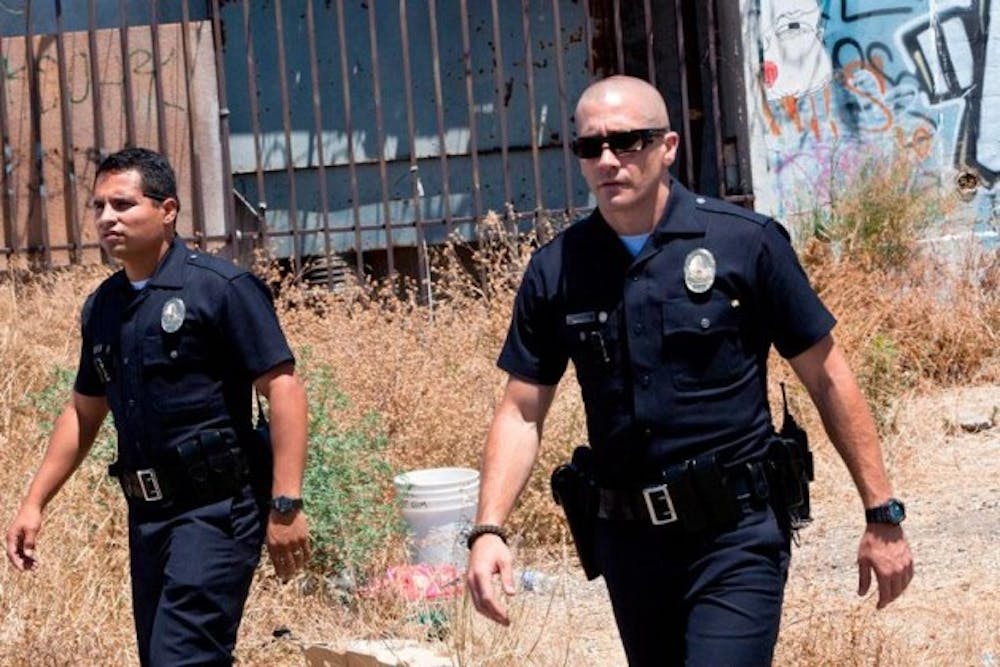Film:End of Watch
Release Date:Sept. 21
Studio:Open Road Films
Grade:A
Two cops bound to a life-defining comradeship. These officers bleed blue while shielding and serving the community and each other. They don't only enforce the law - they coexist with it.
Simply put, End of Watch is the best cop movie of its time, and it's one of the most original crime dramas ever told. Disguised as an off-the-shelf cop-buddy flick, Watch exotically hatches into a barbaric gangland epic. This film effortlessly projects its audience into the action, serving as nearly true testimony to what the real LAPD officers might actually do on an ordinary workday.
The opening scene says it all. Shot from the perspective of the police car dashboard, the camera pursues a reckless driver. Background dialogue is heard from officer Brian Taylor (Jake Gyllenhaal, Source Code) and his partner officer Mike Zavala (Michael Pena, Tower Heist).
After a galvanizing hunt through Los Angeles slums, the targeted car crashes and the two passengers open fire only to be unloaded on by the cops. This chase is the perfect beginning to the film and automatically sucks the audience into the perspective of the police.
Taylor and Zavala are the notorious hotheaded duo of their precinct. Taylor personally greets the audience on a handheld camera as part of his project for law school. He introduces Zavala and right away the audience comprehends the importance of the officers' friendship. They often refer to each other simply as partner - not just Taylor or Zavala. They carry casual conversations during patrol about their love lives or lack thereof.
One day, their sergeant (Frank Grillo, Lay the Favorite) appoints them to oversee a new sector of neighborhoods occupied by the Mexican cartel. Taylor is impassioned to make a dent in this syndicate, much to Zavala's dismay.
They meet the cartel ringleader Big Evil (Maurice Compte, Breaking Bad), who declares war on both of them. Taylor and Zavala ransack house after house in an attempt to discover any evidence to charge Evil and his satanic homeboys. The film manages to do so with as little action as possible and instead relies on old-fashioned suspense to work the audience.
What's most striking about End of Watch is its relentlessness in simplistic storytelling. It relies on the pure relationship between two dedicated cops who have lives behind the crime scene.
End of Watch has flawless cinematography. Most of the footage is captured through Taylor's handheld camera, which engages viewers rather than distracts them. The film knows not to restrict itself to pure Blaire Witch mode and uses conventional cameras outside of the handheld.
Third-time director David Ayer (Street Kings) knows this genreall too well. He penned premium police films in Training Day, S.W.A.T. and Dark Blue, while also screenwriting this film. Ayer has been an L.A. native since his teenage years and owns first-hand knowledge of the subject.
Ayer rested most of his film on the natural acting of Gyllenhaal and Pena, who handed in some of their best performances. Their bond is more or less believable, providing extra dimensions that undertone the whole film. The well being of Taylor and Zavala matters to the audience as much as it matters the characters. If something happens to one of them, the audience knows that the other is left in agonizing isolation.
This is as real as a cop thriller gets. There are a handful of scenes that are arguably preposterous but in the end, the audience can successfully suspend any disbelief.
Email: arts@ubspectrum.com





